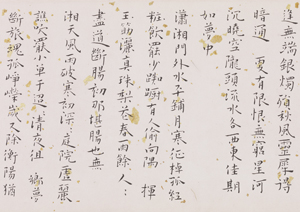Essay
This hanging scroll of calligraphy written in cursive script was made in the year wuwu (戊午1978) when Ch’ung-ho Chang Frankel (born 1913) was sixty-five years old. Thinking of earlier times, she writes her poem, "Inspired by a Visit to Yun Long Buddhist Hall" (yunlong fotang jishi 雲龍佛堂即事), which she composed in Kunming, Yunnan province, around 1939, during the Sino-Japanese War (1937-1945). Yunlong fotang was a Buddhist hall in the place where she resided in Kunming at that time and where she often spent her leisure time. The poem mentions "Clouds and Rivers of the Xiao and Xiang" xiaoxiang yunshui (瀟湘雲水); the musical instrument, a zither or qin (琴) music; Lake Jianlong (見龍), and Baohong (寶紅), a place in Yunan famous for the production of tea. The poem also mentions the activities of playing qin, watching flowers, and drinking tea, all of which suggest the elegant lifestyle of Chang Ch'ung-ho who comes from a very well-educated, traditional Chinese family.Chang was in Kunming from 1938 to 1940. Qianshen Bai ed., Selected Works of Chang Ch’ung-ho’s Poetry, Calligraphy, and Painting (Beijing: SDX Joint Publishing Company, 2010): 106. Qianshen Bai, “Literati Legacy in the Modern Era: Ch’ung-ho Chang Frankel and Friends,” in Mimi Gardner Gates ed., Fragrance of the Past: Chinese Calligraphy and Painting by Ch’ung-ho Chang Frankel and Friends (Seattle: Seattle Art Museum, 2006): 9.
Chang is adept at and well versed in different scripts of Chinese calligraphy. But she is particularly famous for the small standard script, so such a modest-sized hanging scroll of refined calligraphy in cursive script is not commonly seen among her works. The poem is written in five lines on a sheet of blue paper. The first three lines are the text, nine to ten characters to a line, while the fourth and fifth lines are the poem's title and the calligrapher’s signature respectively. All the characters are executed in centered-tip (zhongfeng 中鋒) and slanting-tip (cefeng 側鋒) brushstrokes, angular or round. Devoid of exaggerated strokes, the entire work is both elegant and powerful. The angular strokes of the characters “hua” (花), “yi” (一), “guo” (過) and “jian”(見) are in the style of draft cursive script (zhangcao 章草).Selected Works of Chang Ch’ung-ho’s Poetry, Calligraphy, and Painting: 106. However, overall, the fluent rhythm of the brushwork is reminiscent of Treatise on Calligraphy (Shupu 書譜) by Sun Guoting (孫過庭648–703) of the Tang dynasty, the original preserved as a handscroll in the National Palace Museum, Taipei. It is interesting to note that Hans and Chang Ch'ung-ho Frankel translated the text.See Chang, Ch’ung-ho and Frankel, Hans. Two Chinese Treatises on Calligraphy: Treatise on Calligraphy (Shu pu) [by] Sun Qianli; Sequel to the "Treatise on Calligraphy" (Xu shu pu) [by] Jiang Kui (Shu Pu : Sequel to the "Treatise on Calligraphy"). New Haven: Yale University Press, 1995.In Kunming, Chang named her studio “Hut of Clouds and Dragons” (yunlongan 雲龍盦), and asked the paleographer Tang Lan 唐蘭 (1900–1979) to write it in oracle bone script.The calligraphy work by Tang Lan is now in the collection of Seattle Art Museum (accession number 2010.9.4). She used this studio name for over seventy years.Since Chang’s studio size is small, she also uses another studio name, Banfang半舫 (“a boat”), which is a seal carved by Zhao Mu 趙穆 (1845–1894) of the Qing dynasty which she owned. It is the seal impression in the right upper corner of this hanging scroll. (Note 2.) This suggests that the Buddhist hall and her time in Kungming played an important role in her life. Actually, Peking, Tsinghua, Zhejiang and Nankai universities combined to form the Consolidated University in Kunming during the war. Thus, at that time, Kunming was China’s center of higher education. Therefore, Chang had an opportunity to become well acquainted with many distinguished academic and literary figures such as Zhu Ziqing 朱自清 (1898–1949) and Shen Congwen 沈從文 (1902–1988), for example. Although it was a relatively brief period of time and the country was at war, Chang no doubt enjoyed the company of her scholarly friends.
However, the first sentence of the poem "Having drunk enough wine, having finished playing the zither (琴 qin), my thoughts return to my home," clearly expresses her homesickness during the war for her home in Anhui.The original text is “jiulan qinba fusijia 酒闌琴罷復思家.” The fact that Chang re-wrote her old poem nearly forty years later indicates that her time in Kunming remained an unforgettable, vivid memory. Since Chang Ch'ung-ho settled down in the United States in 1949, returning infrequently to China, she no doubt also missed her motherland, her family and friends.
Therefore, this calligraphy work not only attests to Chang’s poetic talent when she was young, in her twenties, and almost forty years later, her extraordinary skill in cursive script, but also gives us insight into her complex personal memories and feelings about Kunming and China.
© 2013 by the Seattle Art Museum
Questions for thought
Answers
| Add an answerAdd Answer:
overview
Chang Ch'ung-ho Frankel張充和
Quick Facts about the Artist
inscriptions and seals
essay
This hanging scroll of calligraphy written in cursive script was made in the year wuwu (戊午1978) when Ch’ung-ho Chang Frankel (born 1913) was sixty-five years old. Thinking of earlier times, she writes her poem, "Inspired by a Visit to Yun Long Buddhist Hall" (yunlong fotang jishi 雲龍佛堂即事), which she composed in Kunming, Yunnan province, around 1939, during the Sino-Japanese War (1937-1945).
